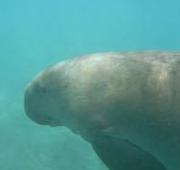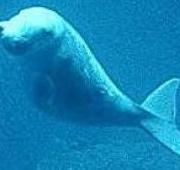 The dugong is a large marine mammal found in the warm waters surrounding Indonesia and Australia. Although the dugong can be found widely throughout the Indo-Pacific tropics, the highest population of the dugong is concentrated around northern Australia.
The dugong is a large marine mammal found in the warm waters surrounding Indonesia and Australia. Although the dugong can be found widely throughout the Indo-Pacific tropics, the highest population of the dugong is concentrated around northern Australia. Although the dugong looks extremely similar to a manatee, the two are different species. The dugong and the manatee are very closely related and can look almost identical until you look at their tail. The tail of the dugong is typically forked like the tail of a shark, where the tail of the manatee is broad and flat, and slightly more flipper looking than fin looking.
Although the dugong looks extremely similar to a manatee, the two are different species. The dugong and the manatee are very closely related and can look almost identical until you look at their tail. The tail of the dugong is typically forked like the tail of a shark, where the tail of the manatee is broad and flat, and slightly more flipper looking than fin looking.


Dugongs inhabit the warm shallow waters, and despite their large size, dugongs are strictly herbivorous animals and have been referred to as the cows of the sea. Dugongs graze on sea grasses and aquatic plants that grow in abundance in the tropical shallows. Dugongs eat large amounts of sea plants and often leave feeding trails behind of bare sand and uprooted sea grass.
Female dugongs give birth to just one calf about once every five years. The baby dugong is born underwater in the warm shallows, where the baby dugong is immediately able to swim to the surface in order to take its first breath. When the baby dugong is born, the dugong calf is about a meter in length and weighs about 20 kg. The dugong calf will stay close to its mother until the baby dugong is about 2 years old.
Dugong populations are constantly decreasing, with many dugongs being accidental victims in large commercial fishing. Dugongs are now considered to be vulnerable animals but the dugong will commonly get older than 70 years of age. Dugong calves will not reach their full size until they are about 15 years old.

